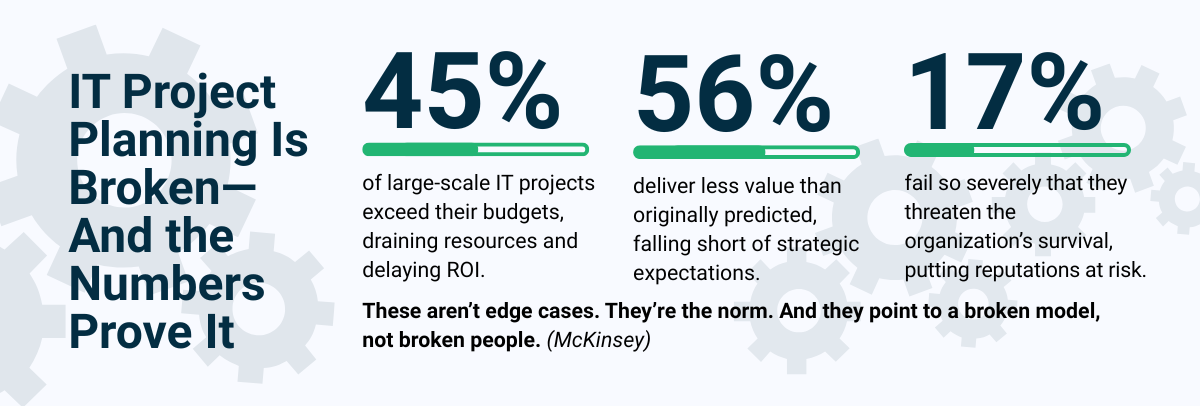
IT projects are digital transformation engines, yet nearly half of them fail. According to the 2023 Standish Group Chaos Report, only 35% of IT projects succeed, 19% are outright failures, and 46% are challenged—delivered late, over budget, or with reduced functionality. Today, IT projects are growth drivers, customer experience enablers, and critical to strategic transformation. In a digital-first economy, where speed and precision define competitive advantage, poor IT project planning isn’t just costly—it’s existential. So, what makes IT project planning so challenging today?
It’s not just the technical complexity—the intertwined decisions, shifting business priorities, compliance pressures, and evolving user expectations. Additionally, cross-functional teams, rapidly growing tech stacks, tightening budgets, and increasing regulatory demands create a perfect storm. Traditional planning methods, built on static timelines and reactive adjustments, struggle to keep pace. What you need isn’t just better planning. You need better foresight.
This article explores how IT project planning must change—why legacy practices no longer cut it, the real challenges, and how predictive, AI-powered strategies now define project success. If your teams are constantly playing catch-up, it’s time to rethink how you plan, not just how you work.
To understand how IT project planning can evolve, let’s first ground ourselves in what a well-structured IT project plan entails.
What Is an IT Project Plan?
A project plan—often called a work plan—is a comprehensive, structured document that outlines a project's full scope and strategy. It defines what is being delivered, why it matters, how it will be executed, and who is responsible at every phase.
It is the central source of truth for aligning stakeholders, managing expectations, tracking progress, and ensuring accountability. It provides the clarity and control necessary to deliver results on time and within budget.
At its core, a project plan outlines:
- The scope of the project
- Clearly defined goals and objectives
- All major tasks and deliverables
- Key milestones and deadlines
- Assigned roles and responsibilities
- Communication protocols to avoid misfires
- The budget and resource needs
It keeps everyone aligned, anticipates needs early, and ensures momentum toward successful delivery.
But having a detailed project plan on paper isn’t enough—its real value lies in how effectively it drives strategic execution across the organization.
Why Project Planning Is Essential to Strategic Execution
Project planning is a critical function determining whether a project delivers measurable outcomes or fails to meet expectations. A well-defined project plan aligns strategy with execution by setting clear parameters for scope, objectives, timelines, resources, and accountability. It enables proactive decision-making, minimizes risk exposure, and ensures all contributors operate from a shared, verified framework.
Without a structured plan, even high-potential initiatives are vulnerable to failure. Unchecked scope expansion, missed deadlines, resource mismanagement, and stakeholder misalignment become inevitable. A strategic IT project plan mitigates these risks by transforming vision into a controlled, executable roadmap, with clearly assigned responsibilities and defined success metrics.
To move from strategy to results, the real challenge lies in building an IT project plan that doesn’t just look good on paper but actually delivers with precision. Here’s how to do it right.
IT project planning isn’t optional—it’s your execution engine. Discover how to turn strategy into results with a smarter, more accountable IT project planning approach. Get the roadmap that delivers—not just documents. Get started with TrueProject QuickStart today.
How to Build a Project Plan That Delivers with Precision
A strong project plan provides the structure, accountability, and foresight required for consistent, measurable success. The following steps outline a strategic approach to planning that supports alignment, control, and stakeholder confidence.
1. Identify All Stakeholders Early: Establish a comprehensive stakeholder list that includes anyone who influences, funds, is affected by, or holds a vested interest in the project. This ensures informed decision-making, reduces resistance, and strengthens alignment from the outset.
2. Clarify Roles and Responsibilities: Clearly define each stakeholder's scope of responsibility. Avoid vague titles or overlapping accountabilities. Every contributor should understand their deliverables, report lines, and expected outcomes.
3. Facilitate Initial Alignment: Conduct a formal project kickoff meeting to align stakeholders around the vision, scope, timelines, budget, and governance. Ensure consensus on strategic objectives, success metrics, and execution boundaries.
4. Establish Concrete Objectives and Deliverables: Translate business goals into specific, measurable outcomes. Define success in terms of quality, functionality, and impact, so expectations are consistent and measurable across all levels of the organization.
5. Prioritize Tasks and Dependencies: Develop a structured work breakdown. Prioritize tasks based on business value, urgency, and interdependencies. Utilize tools like Gantt charts or dependency maps to ensure sequencing and coordination are logically sound.
6. Create a Realistic, Resource-Aware Timeline: Build a project schedule that reflects actual resource availability, task durations, and potential constraints. Avoid overly aggressive timelines that introduce unnecessary risk and reduce delivery quality.
7. Conduct a Comprehensive Risk Assessment: Identify operational, technical, financial, and compliance-related risks in advance. Document mitigation strategies and assign clear ownership for monitoring and response throughout the project lifecycle.
8. Define a Communication Framework: Establish communication protocols for stakeholders, sponsors, and team members. Define reporting cadence, escalation paths, and channels to ensure timely, transparent, and consistent updates across the board.
9. Implement Continuous Monitoring and Adjustment: Treat the project plan as a dynamic asset. Monitor project progress against key milestones and revise the plan in response to changing requirements, emerging risks, or stakeholder feedback.
10. Conduct a Post-Implementation Review: Once the project is complete, perform a structured evaluation of outcomes, challenges, and lessons learned. Document insights to inform future projects and strengthen organizational project maturity.
Even with the right steps in place, many IT project plans still fall short. To fix planning, we first need to understand why it keeps breaking down and what’s really causing it.
Why IT Project Planning Is Broken—And What’s Really Causing It
We’ve been trained to believe that failed projects result from poor execution. But the real failure usually begins long before execution starts—at the planning stage. The initial scope isn’t aligned. Stakeholders aren’t fully bought in. Risks aren’t modeled. Dependencies aren’t tracked. And yet, everyone proceeds as though the plan is bulletproof.
The cracks begin subtly: a delay in stakeholder feedback, a dependency that hits a bottleneck, a new regulation that wasn’t accounted for. One by one, they pull the project off course. But because the plan isn’t dynamic, course correction only happens after visible damage.

Common Challenges in IT Project Planning
1. Scope Creep and Requirement Volatility: Clients and stakeholders often shift priorities mid-project, and initial requirements are rarely complete. PMI’s Pulse of the Profession (2018) study found that 37% of failed projects cite changing objectives as a primary cause. Without a structured way to manage evolving demands, teams waste time reworking deliverables instead of driving progress.
2. Lack of Stakeholder Alignment: When business units, IT teams, and leadership operate in silos, misalignment is inevitable. Conflicting goals lead to friction, while communication breakdowns result in costly rework.
3. Unrealistic Timelines and Resource Allocation: Pressure to deliver quickly often leads to compressed schedules and understaffed teams. The PMI notes that 27% of projects fail due to inaccurate time estimates, leaving no room for technical debt or unexpected roadblocks.
4. Poor Risk Identification and Management: Most organizations react to risks rather than anticipate them. Without a proactive framework, minor issues escalate into crises. McKinsey research reveals that 60% of IT project risks go unaddressed until they cause delays or cost overruns.
5. Insufficient Monitoring and Change Control: Traditional status reports offer lagging indicators—when problems surface, they’re expensive to fix.
6. Cultural and Organizational Silos: When tech and non-tech teams speak different languages, collaboration suffers. Resistance to hybrid methodologies (Agile + Waterfall) further stifles adaptability. An American Management Association study highlights that 83% of executives acknowledged the existence of silos within their organizations, with 97% stating these silos harmed business performance.
7. Tools That Track but Don’t Anticipate: Today’s project management platforms show tasks, timelines, and updates. But they don’t tell you what’s likely to derail. They don’t analyze patterns. They don’t warn you when collaboration drops or stakeholder sentiment turns negative.
But here’s the deeper problem: even when teams recognize these challenges, the project management solutions they rely on aren’t built to fix them—they’re built to document failure after the fact. And that’s exactly where traditional IT project planning tools fall short.

Why Traditional IT Project Planning Tools Are Failing
Today, project management solutions excel at task tracking but fall short in foresight. They’re built for documentation, not prediction.
- Static Dashboards = Rearview Mirror Leadership – They tell you where you’ve been, not where you’re headed.
- Manual Updates Breed Errors – Project data is often outdated or incorrect due to human delays.
- No Pulse on Team Morale – Burnout and disengagement fester in the shadows.
- Hybrid Workflows? Not Supported – Most tools force teams into rigid Agile or Waterfall boxes.
What if your tools didn’t just track work, but actively guided it? The future of IT project planning isn’t about tracking—it’s about anticipating. To truly overcome the blind spots of traditional tools, IT project planning needs a more innovative approach—one that doesn’t just react to issues but predicts them before they happen.
Predictive Project Management for IT Project Planning
So, what does modern IT project planning require? It requires a shift from static planning to dynamic prediction, from inputs to insight, from progress charts to behavioral signals. This is where predictive project management emerges.
Predictive project management enables smarter IT project planning despite shifting scopes, internal disruptions, or unforeseen risks.
- It doesn't just see that a task is late—it understands why.
- It doesn’t just report progress—it forecasts risk.
- It doesn’t just gather feedback—it interprets sentiment shifts to warn of deeper misalignment.
Predictive project management isn’t about replacing your existing solutions; it’s about augmenting them with intelligence. By analyzing historical data, real-time inputs, and behavioral signals, AI-driven platforms forecast risks before they materialize.
How It Solves the Unseen Problems
- Proactive Risk Detection – The predictive project management solution flags early budget overruns, timeline slips, and team burnout.
- Real-Time Stakeholder Sentiment Tracking – Detect misalignment before it escalates.
- Dynamic Resource Optimization – Studies reveal that predictive planning reduces costs by 10% and improves operational efficiency by 20%.
The future of IT project planning isn’t reactive—it’s predictive. The only question is: Will you lead the shift or get left behind?
Ready to rethink IT project planning? Stop reacting to issues and start predicting them. Discover how predictive project management can transform your planning from static to strategic. Explore the future of IT project planning.

Conclusion: From IT Project Planning to Predicting—The New Imperative
The IT project landscape has changed, but too many IT project planning processes are still stuck in the past. Project failure rarely stems from poor execution alone. It begins with misalignment, blind spots, and an overreliance on static tools that merely document progress rather than anticipate disruption. In today’s high-stakes, digital-first environment, that’s dangerous.
Modern IT initiatives are no longer just about delivering features. They enable transformation, drive revenue, and shape customer experience. That level of responsibility demands a new kind of project development planning that goes beyond task lists and timelines to surface hidden risks, real-time signals, and the dynamics that derail success before they become visible.
Predictive project management is a necessity today. It redefines planning as an active, intelligent process that interprets behavior, forecasts outcomes, and guides teams with foresight rather than hindsight. It ensures your plans adapt at the speed of your business.
This is where TrueProject, a KPI-based predictive project management SaaS solution that improves project health and performance, sets a new standard. Unlike traditional project management solutions that stop at status reporting, TrueProject transforms planning into strategic intelligence. It continuously analyzes real-time feedback, stakeholder sentiment, behavioral patterns, and risk signals, giving IT leaders the early warnings and actionable insights they need to course-correct before it's too late. It’s not just about managing projects—it’s about ensuring they succeed.
With TrueProject, you don’t just keep projects on track—you elevate how your organization plans, executes, and delivers impact. It’s the edge every IT leader needs in a world where precision, speed, and accountability are non-negotiable.
The future of IT project planning is not reactive. It’s predictive, dynamic, and insight-driven. Those who embrace it will move faster, fail less, and lead the market. The rest? They’ll be left reacting to yesterday’s problems, while today’s leaders build tomorrow.
Stop planning for what’s visible—start predicting what’s next. Experience how TrueProject can elevate your IT project planning from reactive to predictive. See the future of your projects before it unfolds. Schedule your personalized demo now.






